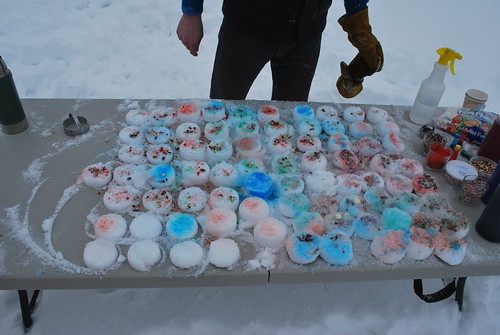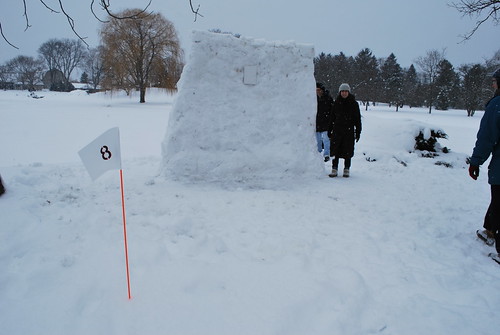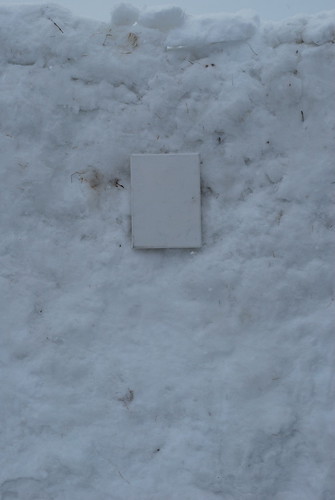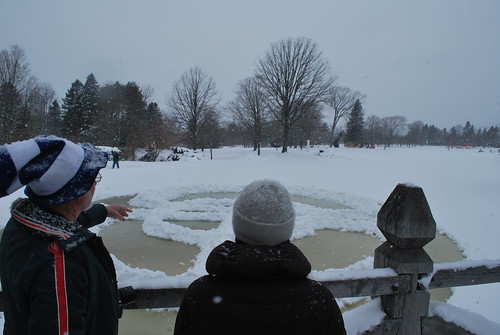Our apologies for keeping everyone on the edges of their seats as they awaited the outcome of the YouSnow event. With spring making a sudden appearance up here at Lynden, we’ve been watching the snow recede and the turkeys reappear. Still, as Willy has shown in a prior post, the traces of snow sculptures remain on the grounds, and may even be visible on Sunday (from my window I can see a miniature version of the Cucullu/Matthes wall across the lake, more of a fence than a fortress).
Our thanks to Emilia Layden and Paul Druecke, our esteemed judges. They spent an hour trekking around the grounds in the snow in the late afternoon during Winter Carnival looking at projects and talking to artists. The snow sculptures were a marvel of ingenuity—so many ways to shape, arrange, imprint or ingest the snow! Best of all, each sculpture enabled us to see the garden, at least for a little while, in a new way.
The judges began with the delicious Snownuts purveyed by Cody Frei of the 62nd Dimension (though they had to fight for space at the table with two very serious young Snownut-makers).

Her performance completed, Sara Caron met the judges on the path to explain her project. Armed with a cell phone and a loaf of bread, Sara traced a friend’s path between her car and the Capitol in Madison in a field of snow. The directions were relayed in real time over the phone, allowing the artist and her double to walk together. Sara left a trail of breadcrumbs as well as her footsteps in the field of snow.

Amanda Tollefson returned to her tree perch to greet the judges. She explained that she had abandoned her original plan when she discovered how un-packable the snow was (a sketch of the proposed structure hung from a branch) and instead had taken up residence in the tree.

A little farther along, Katie Kraft’s giant bracelet had taken on a welter of blue markings, thanks to passing participants. (Just the other day we brought in the braided rope that was all that remained of the piece after the weather changed.)

Colin Matthes and Santiago Cucullu showed off a small white painting on a thick white wall—one of the afternoon’s major engineering feats. Intriguingly, this extemporaneous gallery faced the woods to the south; if you positioned yourself in front of the painting the wall effectively usurped the entire sculpture garden, obliterating the view of lake, sculptures and buildings.


Roy Staab showed off his piece, now called Prosperity, from the bridge. He and his crew had battled the dread double ice on the lake, breaking through the top layer into the slushy water that rested on top of the very thick layer below. Lots of wet socks, shoes and pants, as well as a video, which can be seen by clicking the image below (yes, it did snow that day!).

Richard Galling wrapped up his solo labors and showed his minimalist sculpture to the judges.


KT Hancock, Sam Scheller and Tina Graziano also explained their work, a snow intervention in the crotch of a tree, and led the judges around to the far side to show a hidden detail.



The judging ended on a high note with a formal presentation by Jade Pergl, who told Paul and Emilia about the tool she and her sister Mia and father Will had built before the carnival to make their path in the snow. She expertly fielded questions about color and route choices, impressing the judges and their entourage (by now many of the artists were following along).

Emilia and Paul retreated into the house to make their final decisions, emerging after a long period to announce the winners. They admitted that it was a difficult decision, and thanked all the artists for their inspired work.
The Grand Prize, a snow painting by John Riepenhoff, went to Sara Caron.
The two First Prizes, gift certificates to Utrecht, went to Richard Galling and to the team of KT Hancock, Sam Scheller and Tina Graziano.
All the participants received memberships to Lynden, where we hope to see them often in the coming months. Special thanks to our friends at Boswell Book Company, who provided rewards for the judges. And of course to John Riepenhoff, for organizing YouSnow and The Pond Is Our Canvas.
For a very comprehensive collection of photos from the Winter Carnival, visit us on flickr.